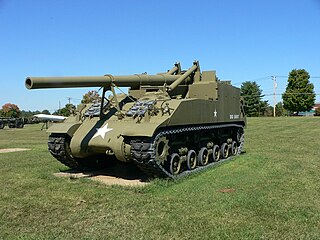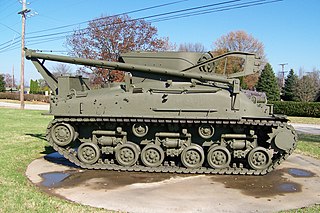
The M4 Sherman, officially Medium Tank, M4, was the most widely used medium tank by the United States and Western Allies in World War II. The M4 Sherman proved to be reliable, relatively cheap to produce, and available in great numbers. It was also the basis of several other armored fighting vehicles including self-propelled artillery, tank destroyers, and armored recovery vehicles. Tens of thousands were distributed through the Lend-Lease program to the British Commonwealth and Soviet Union. The tank was named by the British after the American Civil War General William Tecumseh Sherman.

The M26 Pershing is a heavy tank/medium tank formerly used by the United States Army. It was used in the last months of World War II during the Invasion of Germany and extensively during the Korean War. The tank was named after General of the Armies John J. Pershing, who led the American Expeditionary Force in Europe in World War I.

The M48 Patton is an American first-generation main battle tank (MBT) introduced in February 1952, being designated as the 90mm Gun Tank: M48. It was designed as a replacement for the M26 Pershing, M4 Sherman, M46 and M47 Patton tanks, and was the main battle tank of the U.S. Army and U.S. Marine Corps in the Vietnam War. Nearly 12,000 M48s were built, mainly by Chrysler and American Locomotive Company, from 1952 to 1961. The M48 Patton was the first U.S. medium gun tank with a four-man crew, featuring a centerline driver's compartment and no bow machine gunner. As with nearly all new armored vehicles it had a wide variety of suspension systems, cupola styles, power packs, fenders and other details among individual tanks.

The M47 Patton was an American Medium tank, a development of the M46 Patton mounting an updated turret, and was in turn further developed as the M48 Patton. It was the second American tank to be named after General George S. Patton, commander of the U.S. Third Army during World War II and one of the earliest American advocates of tanks in battle.

An armoured recovery vehicle (ARV) is typically a powerful tank or armoured personnel carrier (APC) chassis modified for use during combat for military vehicle recovery (towing) or repair of battle-damaged, stuck, and/or inoperable armoured fighting vehicles, such as tanks and armoured personnel carriers. Most ARVs have motorized tracks, like a tank or bulldozer, enabling the ARV to operate on uneven ground. The term "Armoured Repair and Recovery Vehicle" (ARRV) is also used.

The M4 Sherman tank was produced in several variants, a result of mass production spread across several manufacturers and several years. It was also the basis for a number of related vehicles and Shermans have been modified by several nations, ranging from upgrades to complete hull conversions for another task. Originally designed in 1941, M4 variants were still used by Israel during the 1967 and 1973 wars with its Arab neighbors.

An artillery tractor, also referred to as a gun tractor, is a specialized heavy-duty form of tractor unit used to tow artillery pieces of varying weights and calibres. It may be wheeled, tracked, or half-tracked.

The M46 Patton is an American medium tank designed to replace the M26 Pershing and M4 Sherman. It was one of the U.S Army's principal medium tanks of the early Cold War, with models in service from 1949 until the mid-1950s. It was not widely used by U.S. Cold War allies, being exported only to Belgium, and only in small numbers to train crews on the upcoming M47 Patton.

The 155 mm Gun Motor Carriage M40 was an American self-propelled artillery vehicle built on a widened and lengthened Medium Tank M4A3 chassis, but with a Continental engine and with HVSS, which was introduced at the end of the Second World War.

This article deals with Sherman tanks extensive use around the world after World War II and catalogues foreign post–World War II use and conversions of Sherman tanks and variants based on the Sherman chassis.

The M19 Tank Transporter was a heavy tank transporter system used in World War II and into the 1950s. It consisted of a 12-ton 6×4 M20 Diamond T Model 980 truck and companion 12-wheel M9 trailer.

The United States provided tens of thousands of its Medium Tank M4, also named the Sherman, to many of its Allies during the Second World War, under the terms of Lend-Lease.

The M88 Recovery Vehicle is one of the largest armored recovery vehicles (ARV) in use by United States Armed Forces. There are three variants, the M88, the M88A1, and the M88A2 HERCULES. The M88 series has seen action in the Vietnam War, the Persian Gulf War, the Iraq War, and the War in Afghanistan, and to a lesser extent during the Kosovo War, where they were deployed to help recover heavy armored vehicles of the Allied ground units. As of 2000, the M88A2 replacement cost was around US$2,050,000.

The Ford GAA engine is an American all-aluminum 32-valve DOHC 60-degree liquid-cooled V8 internal combustion engine with a flat-plane crank designed and produced by the Ford Motor Company before and during World War II. It features twin Stromberg NA-Y5-G carburetors, dual magnetos and twin spark plugs making up a full dual ignition system, and crossflow induction. It displaces 1,100 cu in (18 L) and puts out well over 1,000 pound-feet (1,400 N⋅m) of torque from idle to 2,200 rpm. The factory-rated net output was 500 hp (370 kW) at 2,600 rpm.

The M25 Tank Transporter (G160) was a combination 6x6 M26 armored heavy tank transporter/tank recovery tractor and companion 40-ton M15 trailer introduced into US Army service in Europe in 1944–45. Manufactured by Pacific Car & Foundry Co., it was a substantial upgrade over the Diamond T M19 transporter/trailer duo introduced in 1940.

The United States has produced tanks since their inception in World War I, up until the present day. While there were several American experiments in tank design, the first American tanks to see service were copies of French light tanks and a joint heavy tank design with the United Kingdom.

The history and development of the tank in the South Korea spans the period from their adoption after World War II with the foundation of the South Korean army, into the Cold War and the present. Over this period Korea has moved from being an operator of United States designed and produced tanks to being the designer and manufacturer of tanks in its own right.

The M32 Armored Recovery Vehicle was an armored recovery vehicle (ARV) used during World War II and the Korean War by the United States, and was based on the chassis of the M4 Sherman medium tank. During World War II, the British also used several hundred M32s, which were obtained through Lend-Lease in 1944. The first four prototypes were produced in January 1943, labeled T5, T5E1, T5E2, T5E3, and T5E4. After a series of tests at the Aberdeen Proving Grounds, the prototypes were approved as M32, M32E1, M32E2, M32E3, and M32E4. However, the M32E4 never entered production. There were also variants that had Horizontal Volute Spring Suspension (HVSS), which were demarcated by the suffix "A1" after the model number.

The Bergepanzer 2 is an armored recovery vehicle based on the Leopard 1 main battle tank, developed in the 1960s and manufactured by Atlas-MaK Maschinenbau for the West German army. It first entered service in 1966 and replaced the earlier Bergepanzer 1. Various versions have served in the armed forces of Germany and other countries. It was later succeeded by the Bergepanzer 3 "Büffel".



















